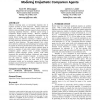61 search results - page 6 / 13 » The complexity of learning according to two models of a drif... |
IJMMS
2007
13 years 7 months ago
2007
Affective reasoning plays an increasingly important role in cognitive accounts of social interaction. Humans continuously assess one another's situational context, modify the...
ATAL
2006
Springer
13 years 11 months ago
2006
Springer
Affective reasoning plays an increasingly important role in cognitive accounts of social interaction. Humans continuously assess one another's situational context, modify the...
ATAL
2004
Springer
14 years 23 days ago
2004
Springer
Multi-agent research often borrows from biology, where remarkable examples of collective intelligence may be found. One interesting example is ant colonies’ use of pheromones as...
CEC
2007
IEEE
14 years 1 months ago
2007
IEEE
— Chemotaxis can be defined as an innate behavioural response by an organism to a directional stimulus, in which bacteria, and other single-cell or multicellular organisms direct...
BMCBI
2008
13 years 7 months ago
2008
Background: Prediction of disulfide bridges from protein sequences is useful for characterizing structural and functional properties of proteins. Several methods based on differen...

